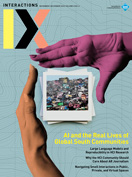Authors:
Juan Li, Hemin Du, Junfeng Wang
Breast milk is the most natural source of nutrition for infants, and breastfeeding plays a vital role in the physiological and psychological health of mothers and infants. Smooth breastfeeding is a key factor in establishing a positive emotional bond between mothers and infants. Desley Hegney et al. [1] reported that about half of mothers see breastfeeding as a way to establish contact with their babies, and that difficult breastfeeding is emotionally challenging. Koa Whittingham and Amy Mitchell [2] concluded that negative breastfeeding experiences had an impact on the mother-infant relationship. They emphasized the importance of breastfeeding support, which is…
You must be a member of SIGCHI, a subscriber to ACM's Digital Library, or an interactions subscriber to read the full text of this article.
GET ACCESS
Join ACM SIGCHIIn addition to all of the professional benefits of being a SIGCHI member, members get full access to interactions online content and receive the print version of the magazine bimonthly.
Subscribe to the ACM Digital Library
Get access to all interactions content online and the entire archive of ACM publications dating back to 1954. (Please check with your institution to see if it already has a subscription.)
Subscribe to interactions
Get full access to interactions online content and receive the print version of the magazine bimonthly.






